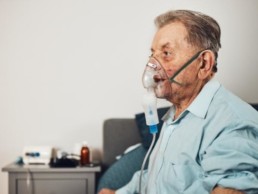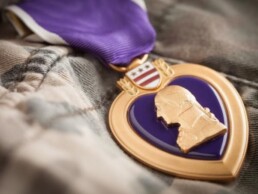Recognizing Our Veterans This Mesothelioma Awareness Day
This September 26th marked the 17-year anniversary of Mesothelioma Awareness Day. This is a day devoted to spreading awareness about this rare and extremely aggressive form of cancer. What many do not know is that mesothelioma is one of the few non-genetic forms of cancer and is usually spoken in tandem with asbestos. Asbestos is the only known culprit of mesothelioma and was heavily used throughout the military from the early 1900s up until the 1980s. Unfortunately, its past use in the military has led to emerging mesothelioma cases today, with roughly 900 new mesothelioma diagnoses annually among our veteran population.
Exposure In The Air Force
For veterans of the Air Force, exposure to asbestos most likely happened on actual Air Force bases. Insulation, wall board, piping, plumbing, sealers, and adhesives were known to contain this carcinogen. Servicemen and women most at risk of exposure were the ones who lived on these bases with their families.
Planes used by the Air Force also contained asbestos in some parts, such as the heat shield, engine, and brake pads. Aircraft mechanics were put at risk as these parts began to wear down and fibers were released into the air. Secondhand exposure was also a risk, as asbestos fibers cling to the clothes. This means that mechanics could have been carrying asbestos off the job site, unknowingly exposing their families when they came home from work for the day.
Exposure In The Coast Guard
Those who served in the Coast Guard were mostly likely to come into contact with asbestos while on shipyards and on ships. Coast Guard Cutters were likely to be harboring asbestos in many different areas of the ship. Pump rooms, boiler rooms, sleeping quarters, and mess halls all could have had asbestos-containing materials (ACMs) present. The close quarters type of living on these vessels allowed for asbestos fibers to travel easily to other areas of the ship, potentially exposing everyone on board. The height of exposure for Coast Guard personnel was during World War II, where usage and production of asbestos was at its peak.
Exposure In The Army
Similar to the Air Force, Army personnel had a high risk of exposure when on Army bases. Insulation, floor tiles, roofing, and cement incorporated this carcinogenic mineral not only because of its fire-resistant qualities, but because it was so cheap. Off-site locations known as Army reserves were also prone to the usage of asbestos. In 2005, the Environmental Protection Agency (EPA) reported that there were still ACMs that needed to be abated from these locations.
Army vehicles also utilized asbestos in some parts that would experience high temperatures and friction. This posed a risk to Army mechanics whose job required them to repair brake pads, gaskets, and clutch plates on vehicles used in combat and transport.
Exposure In The Navy
Navy veterans are the most likely of all military personnel to develop an asbestos-related disease. This is due to the fact that asbestos was most heavily used among this branch of the military. Cruisers, destroyers, aircraft carriers, submarines, and more were often built with ACMs. Asbestos was primarily used in the insulation of these vessels and was also favored because it does not deteriorate easily when in contact with water. The servicemen and women involved in the building, repairing, and retiring of these ships were the ones who most likely were exposed, as the ACMs would degrade overtime.
Exposure In The Marines
Much like the Navy and Coast Guard, veterans of the Marines were also put at risk by being on and working with ships. Marines are often aboard Navy ships being transported to and from conflict areas. While being transported, they carry out maintenance tasks the same as any Navy member would. These duties may involve repairing gaskets or removing insulation, which can disturb and release asbestos. Unfortunately, many of the high-risk ships used throughout World War II and the Vietnam War are still a part of the Navy’s fleet today.
Spreading Awareness
With mesothelioma continuing to affect so many veterans every year, the Purple Heart Foundation believes it is imperative to increase awareness of this disease. This cancer could be diagnosed less, or even disappear, if we are vigilant in protecting ourselves and our military population from asbestos exposure.
Servicemen and Service Dogs: A Life Saving Connection
Our servicemen and women have to restart their lives upon returning home from battle. These new challenges can present circumstances far different from those of war. Facing these challenges head on can be daunting for many. Easing back into society can tough, especially for those who suffer from Post-Traumatic Stress (PTS) and Traumatic Brain Injury (TBI). According to the Veterans Administration (VA), between 11-20% of veterans during Operations Iraqi Freedom (OIF) and Enduring Freedom (OEF) have been diagnosed with PTS in a given year.
There are a variety of ways to ensure that transition is as smooth as possible. One of those methods is pairing a Veteran with a service dog. Suffering from PTS can leave an individual feeling isolated from family and friends. Depression and other emotional disorders can surface as well. The method of service dogs is to provide the veteran with a companion trained to help them with basic needs. However, the animal is indirectly re-teaching the veteran how to care for someone, using emotions as communication, and even how to love.
“We think pet dogs, therapy animals and service animals all have a role to play in peoples’ health and veterans’ health. This is all good news. A cold nose is a powerful motivation to get up in the morning,” said Stave Feldman, executive director of the Human Animal Bond Research Institute Foundation. Mr. Feldman discussed studies between the animals and veterans to The Military Times in a recent article.
“He brought me back from the brink,” said Veteran Colonel Roger Lintz, (US Army – Retired) of his Service Dog – Niles. Living with PTS does take time to accept that life may not be the same. This veteran, who honorably served his country, was able to find true companionship with his new four legged friend. Niles was able to help him with remedial tasks around the house and would wake him from nightmares. These nightmares and other issues with PTS nearly became too much to handle. Col. Lintz believes that his companion saved his life when suicidal thoughts started to cloud his mind. Watch the full interview:
The American Psychology Association and The Society Military Psychology have found that this alternative method could help nearly 40% of veterans. Especially those who do not show signs of improvement after participating in treatments such as prolonged exposure (PE) and cognitive processing therapy (CPT), which are considered the “gold standard” for treating PTS.
Maj. Todd Olsen had participated in multiple tours of duty since enlisting in the Army in 1989. However, coming back after his last mission sent his life into a tailspin. He was suffering from multiple symptoms of PTS, rebuilding a relationship with his two boys, and filing for divorce from his wife.
Some servicemen and women will attend the actual trainings with their service dog. They get to watch them go through obstacle courses, learn commands, and how to save lives. This, in a way, gives the veteran a sense of purpose again. Their life and bond matter as much to the service dog as the service dog means to them.
Maj. Todd Olsen of Pennsylvania told The Daily Progress that, “It’s not so much training the dog, it’s training the veteran and then pairing them up together. So we weren’t teaching them basic obedience, we were learning the commands and the dogs were learning how we give the commands.”
There have been few in-depth studies about the dynamic between a service dog and PTS. However, The Veterans Administration believes that veterans can experience some needed benefits by owning an animal or being paired with a service dog. The VA also counsels that veterans should speak with their doctor and family before applying for a service dog.
What are the emotional benefits of having a dog?
Dogs can make great pets. Having a dog as a pet can benefit anyone who likes dogs, including people with PTS. For example, dogs:
-
Help bring out feelings of love
-
Do things that are different from natural dog behavior
-
Do things that the handler (dog owner) cannot do because of a disability
-
Learn to work with the new handler in ways that help manage the owner’s disability
-
Are good companions
-
Take orders well when trained. This can be very comfortable for a Servicemember or Veteran who was used to giving orders in the military
-
Are fun and can help reduce stress
-
Are a good reason to get out of the house, spend time outdoors, and meet new people
(Source: The Veterans Administration)
Maj. Todd Olsen continues his transition into “civilian life” by working with his service dog and attending yoga classes. He says, “With the yoga for veterans and the dog, and continuing treatment at the VA, it’s putting me back together.”
The Purple Heart Foundation has provided funds to service dog programs totaling $75,000 over the years. The Purple Heart Foundation remains committed to assisting veterans in all aspects of their lives, including service dog programs, other rehabilitative programs, and disability benefits. You can show your support for these brave men and women who have sacrificed so much for our country by making a one-time or monthly pledge to ensure veterans continue to get the support and benefits they deserve by clicking here.
Honoring Purple Heart Month
As we begin the month of August, it is our great pleasure to welcome you to
Purple Heart Month!
This month is dedicated to paying our respects to all the brave men and women wounded or killed in combat. The official Purple Heart Day is observed on the 7th day of August each year, commemorating the historic day in 1782 that General George Washington, Commander-In-Chief of the Continental Army, commissioned the first Purple Heart Medal, originally called the Badge of Military Merit.
The Badge of Military Merit is a purple, heart-shaped piece of silk bound with a thin edge of silver with the word merit embroidered in silver across the face. Only 3 Badges of Military Merit were awarded. The Badge of Military Merit was redesigned and re-commissioned in 1932 by General Douglas McArthur in honor of George Washington’s bicentennial birthday. Now known as the Purple Heart Medal – it is the oldest military award, first being awarded to soldiers in World War I and still given to soldiers today.
A presidential order signed in 1942 permitted the Purple Heart Medal to be awarded to all branches of the military including the U.S. Coast Guard. It was World War II, when the qualification to receive the Purple Heart Medal changed to honor those who were wounded or killed in combat – that is why it’s recipients often call it “the medal that nobody wants”. It is unknown how many soldiers actually received it. However, we know that the soldiers listed below are some of the most awarded Purple Heart Recipients in history:
Robert T. Frederick, U.S. Army: World War II (8)
David H. Hackworth, U.S. Army: Korean War (3), Vietnam War (5)
Joe Hooper, U.S. Army, Medal of Honor: Vietnam War (8)
Robert L. Howard, U.S. Army, Medal of Honor: Vietnam War (8)
William Waugh, U.S. Army: Vietnam War (8)
It took the Purple Heart medal many years to evolve into what it is today. Today, on the reverse of the medal, “FOR MILITARY MERIT” is inscribed. The medal itself is made of brass with a gold color to it, and also contains a bust of George Washington and his coat of arms. The purple color represents the blood of all those who have made sacrifices in war, but traditionally it represent the courage of those who serve. The original color of the medal George Washington created was purple, so it was only fitting that it would be used to honor his memory in the new medal.
The Military Order of the Purple Heart (MOPH) was formed in 1932. It is composed exclusively of men and women who have received the Purple Heart Medal and is the only Veteran’s Service Organization whose membership is comprised solely of “combat-wounded veterans”.
The Military Order of the Purple Heart Service Foundation, also known as the Purple Heart Foundation, was later created in 1957 as a non-profit organization. For more than 60 years, the Purple Heart Foundation has solely dedicated itself to funding programs and services that support our nation’s heroes. Donate to show your support of the Purple Heart Foundation and to help us continue to serve our nation’s veterans who have already sacrificed so much.
DONATE



